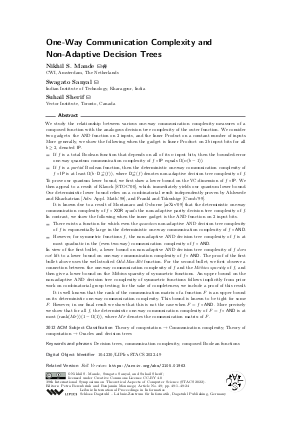@InProceedings{mande_et_al:LIPIcs.STACS.2022.49,
author = {Mande, Nikhil S. and Sanyal, Swagato and Sherif, Suhail},
title = {{One-Way Communication Complexity and Non-Adaptive Decision Trees}},
booktitle = {39th International Symposium on Theoretical Aspects of Computer Science (STACS 2022)},
pages = {49:1--49:24},
series = {Leibniz International Proceedings in Informatics (LIPIcs)},
ISBN = {978-3-95977-222-8},
ISSN = {1868-8969},
year = {2022},
volume = {219},
editor = {Berenbrink, Petra and Monmege, Benjamin},
publisher = {Schloss Dagstuhl -- Leibniz-Zentrum f{\"u}r Informatik},
address = {Dagstuhl, Germany},
URL = {https://drops.dagstuhl.de/entities/document/10.4230/LIPIcs.STACS.2022.49},
URN = {urn:nbn:de:0030-drops-158598},
doi = {10.4230/LIPIcs.STACS.2022.49},
annote = {Keywords: Decision trees, communication complexity, composed Boolean functions}
}

 Creative Commons Attribution 4.0 International license
Creative Commons Attribution 4.0 International license






















